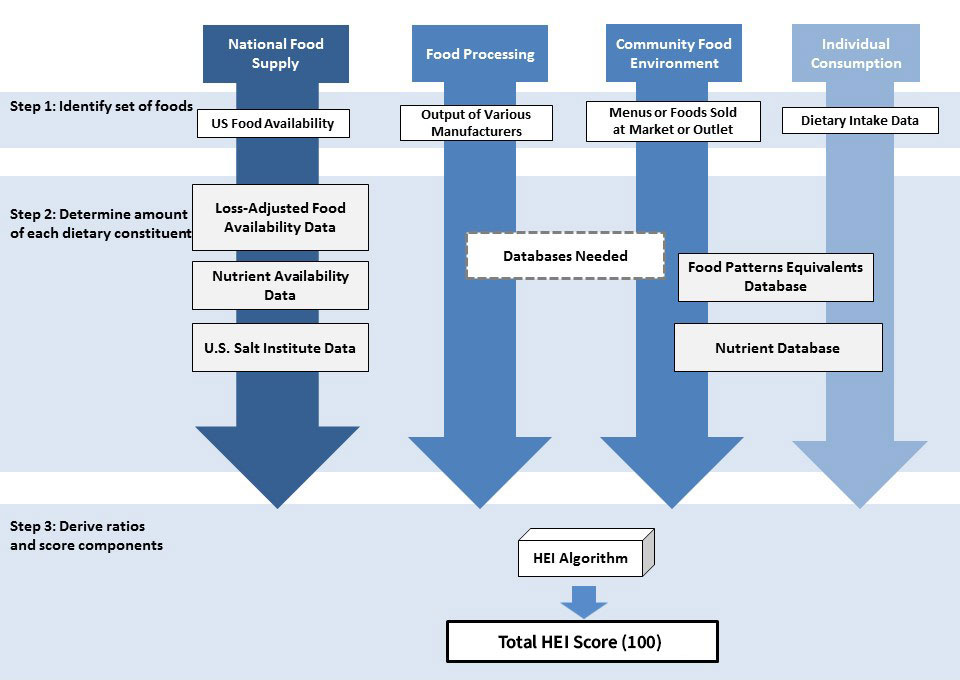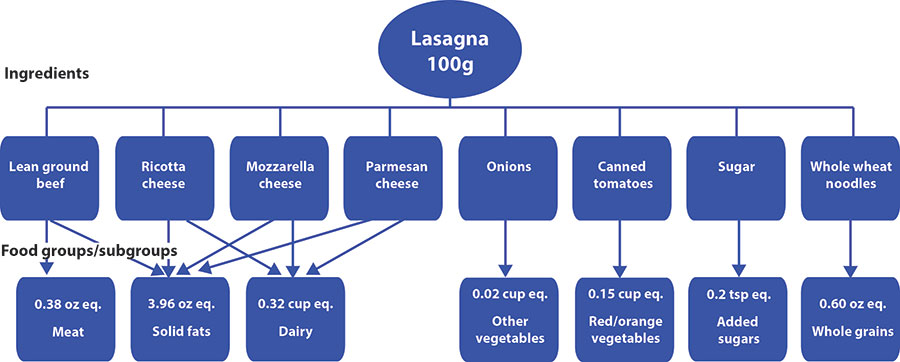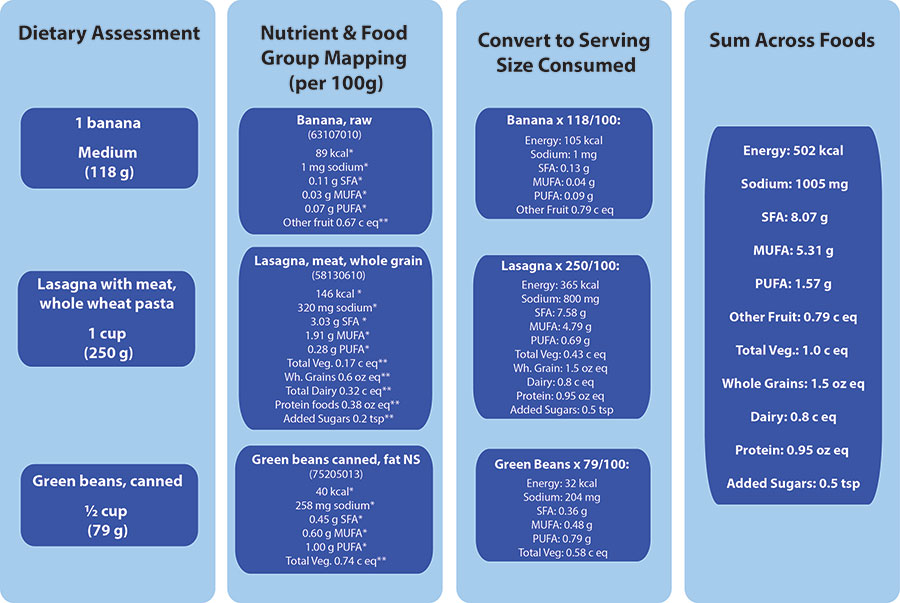
On this page...
Steps for Calculating HEI Scores
An overview of the basic steps for calculating HEI scores are below. The steps below are applicable to both the HEI for 2 years and older and the HEI-Toddlers-2020 for 12 through 23 months. See SAS code ReadMe files for steps necessary to calculate scores. Data preparation steps to remove infant formulas and imputed human milk nutrient values are needed prior to calculating HEI-Toddlers-2020 scores.
Additional resources are available to provide an overview of methods and calculations, to help choose a method, to learn more about how the HEI is used in research, to provide sample SAS code, and to help visualize and interpret scores.

Figure 1: summarizing the three steps for deriving HEI scores across each of the four levels of the food stream. Read the following sections for a complete explanation.
1. Identify the set of foods under consideration:
The set of foods considered could include, for example, the entire US food supply, the sum of choices available, marketed, or sold in a particular environment, or the foods consumed by a person or group of people on a day or over a longer period of time.
2. Determine the amount of each relevant dietary constituent in the set of foods:
The expandable table below shows an example of dietary constituents as labeled in the Food Patterns Equivalents Database (FPED) and the Food and Nutrient Database for Dietary Studies (FNDDS). This table describes the types of dietary variables needed to calculate the score and indicates examples of databases that contain this information. Though energy is included in the table, it is not a component in and of itself, but rather comprises the denominator of most of the component scoring equations.
Dietary Constituents for HEI–2020
| HEI Component | Dietary Constituents1 | Additional Information |
|---|---|---|
| From FPED2 (or other food-based database) | ||
| Total Fruits | Total Fruits in cup equivalents | Includes whole fruits and fruit juice. |
| Whole Fruits | Citrus, Melons, Berries + Other Intact Fruits in cup equivalents | Excludes fruit juice. |
| Total Vegetables | Total Vegetables + Legumes (Beans and Peas) in cup equivalents | |
| Greens and Beans | Dark Green Vegetables + Legumes (Beans and Peas) in cup equivalents | |
| Whole Grains | Whole Grains in ounce equivalents | |
| Dairy | Total Dairy in cup equivalents | Includes all milk products (e.g., fluid milk, yogurt, and cheese). Includes fortified soy milk. Excludes other plant-based milks. |
| Total Protein Foods | Total Meat, Poultry, and Seafood (including organ meats and cured meats) + Eggs + Nuts and Seeds + Soy + Legumes (Beans and Peas) in ounce equivalents | Excludes fortified soy milk (which is included in Dairy). Does not include protein from all sources (e.g., does not include protein from dairy); rather, this component includes foods considered to be part of the food group Protein Foods. Lean faction only (saturated/solid fats are counted separately). |
| Seafood and Plant Proteins | Seafood (high in omega-3) + Seafood (low in omega-3) + Soy + Nuts and Seeds + Legumes (Beans and Peas) in ounce equivalents | Excludes fortified soy milk (which is included in Dairy). |
| Refined Grains | Refined Grains in ounce equivalents | |
| Added Sugars | Added Sugars | Includes caloric sweeteners and syrups used as sweeteners in other food products, and sugar added in food preparation, processing, and at the table. Teaspoon equivalents are converted to energy (kcal) in the scoring process. |
| From FNDDS3 (or other nutrient database) | ||
| Energy | Energy (kilocalories) | Energy from foods and drinks, including alcohol. Does not include energy from supplements or nutritional supplement beverages or formulas. Does not include energy from human milk or infant/toddler formula. |
| Sodium | Sodium | Sodium is converted from milligrams to grams in scoring process. |
| Saturated Fats | Total Saturated Fatty Acids | Saturated fats are calculated in grams but converted to energy (kcal) in the scoring process. |
| Fatty Acids | (Total Monounsaturated Fatty Acids + Total Polyunsaturated Fatty Acids)/Total Saturated Fatty Acids | Calculated as a ratio. |
1 = Dietary constituents in this table come from the Food Patterns Equivalents Database (FPED) and the Food and Nutrient Database for Dietary Studies (FNDDS).
2 = See the FPED overview. Detailed information about the FPED food groups can be found in FPED documentation.
3 = See the FNDDS overview. Detailed information about the FNDDS food groups can be found in FNDDS documentation.

